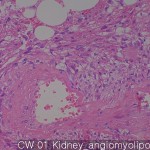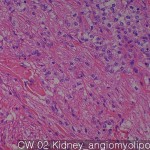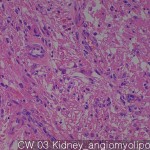| Product name | Lipomatous tumors |
| Cat. No. | CW |
| Current version | CW1 |
| Data sheet | CW1.pdf |
| No. of samples | 59 |
| No. of patients | 59 |
| Core diameter | 2.0 mm |
| Section thickness | 4 micrometer |
| Price | 244 EUR |
| 320 USD | |
| 210 GBP |
Product Related Literature
Lipomatous tumor is a group of common mesenchymal lesion. Over the years, the main changes in the classification of lipomatous tumors, the addition of new variants of some of the lipoma with a lipoma of the subcutaneous tissue and long-term undifferentiated liposarcoma, and awareness of dedifferentiated liposarcoma is included are. Usually lipomatous tumors represent lipoma, almost half of all benign lesions,. In its typical form, they do not present a problem of diagnosis of the pathologist rarely. However, cartilage lipoma lipoma hibernoma, cell angiolipoma, spindle cell / pleomorphic lipoma (for example (eg, intramuscular lipoma, perineural lipoma) and lipoma that occurred in the deep place, unusual characteristics liposarcoma you can stuff with) including and confuse.
In a recent study, cytogenetic reconfirmed the nature of the individual of many variants of lipoma. Rearrangement of lipoma chromosome 12, discovered that can not be found in spindle cell / pleomorphic lipoma or lipoma of multiple often lonely. Liposarcoma is a soft tissue sarcoma in adults the most common. It does not occur from lipoma or existing, from the subcutaneous tissue rarely, it was not found in children rarely. Features of liposarcoma is lipoblast or fat cells immature. The diagnosis lipoblasts, have roasted and eccentricity indentation, the nuclear chromatin by the presence of fat vacuoles of one or more. These cells, (eg, silicone), so you can be found in the reaction nonlipomatous lesions various, these cells, importantly, may result in appropriate histological background. In order to identify the markings environmental cells and those, such as occurs, do not apply a rigorous criterion can lead to over-diagnosis of liposarcoma. Differentiation-differentiated, mucus, round cell, and pleomorphic: liposarcoma is divided into several subtypes. Liposarcoma, can be two major groups, to be conceptualized as occurring in the differentiation / dedifferentiation liposarcoma and round / mucus cell liposarcoma.
Liposarcoma of mucus / round cell occurs in middle-aged as lesions of the extremities mainly. In some cases with transient characteristics, tumor was mucus (below) for pure pure round cells (high-grade lesions). Operation may relate to the size of the circular area of the cell. Chromosome abnormalities consistent characterize the spectrum of lesions. On the other hand, differentiation / dedifferentiation liposarcoma, appears in late adulthood as retroperitoneal lesions and limbs. They are composed of mature fat intertwined with lipoblasts unusual or atypical cell chromatin. These lesions are frequently repeated, but they do not spread. And retroperitoneal lesions and poor prognosis, their actions will affect the location strongly. Long-term complications of the disease, these lesions, there is a possibility that the phenomenon, which provides them with the possibility of metastasis (dedifferentiation) histological proceeds.
Main disease (for example, retroperitoneal) de-differentiation is dependent on the weather phenomenon that occurs at the site where there is a great potential of clinical resistance. As with differentiated liposarcoma, dedifferentiated liposarcoma occurred at the same age, but is much more common in the retroperitoneum. As a small percentage, most lesions, newly generated in the late complication of well-differentiated liposarcoma as described above. They usually are composed of well-differentiated regions associated with nonlipogenic sarcoma as fibrosarcoma or malignant fibrous histiocytoma of the class. However, the degree of histological features occurring in the region of de-differentiation, a higher diversity than previously evaluated. You may have to co-exist with high sarcoma, or can be of inferior area similar to fibrosarcoma inferior or fibromatosis is regarded as a representation only of dedifferentiation.
Atypical anti-tumor lipomatous / well-differentiated liposarcoma is a low-grade mesenchymal tumor with a high propensity for the possibility of dedifferentiation to higher grades over time and local recurrence. However, the public risk of de-differentiation that is different from the local recurrence, follow-up plan and a single treatment was adopted. Research to evaluate the appropriate treatment and clinical long-term action, to follow up the strategy for these tumors have been made. Diagnosed with atypical tumor lipomatous / well-differentiated liposarcoma retrospectively, we will check the files of 101 patients treated between 2008 to 1990. Because it was included in the study information and 67, follow-up minimum of these patients, and were available for two years at our institution, 47 patients (A group) underwent primary surgery , 20 patients (B group), one local recurrence ≥ it was referred to and after. The median follow-up was (229 months from range 24) 81 months.
Atypical lipomatous / well-differentiated liposarcoma was (patients 5 groups of 47 minutes), 4.2% in local recurrence rate of the primary tumor. Atypical lipomatous / well-differentiated liposarcoma was (B patients and 13 group A in 67 minutes) 52% local re-recurrence rate of tumor recurrence. Recurrence, has developed the only 140 months after treatment and diagnosis. Speed of dedifferentiation of recurrence was (1/25 of patients A and B groups of recurrent tumor) 4%. No patient will not develop metastases. Atypical anti-tumor lipomatous / well-differentiated liposarcoma is associated with an increased incidence of risk under the second side of the de-differentiation of recurrence and local recurrence. Long-term follow-up is recommended for early diagnosis and treatment of local recurrence.



